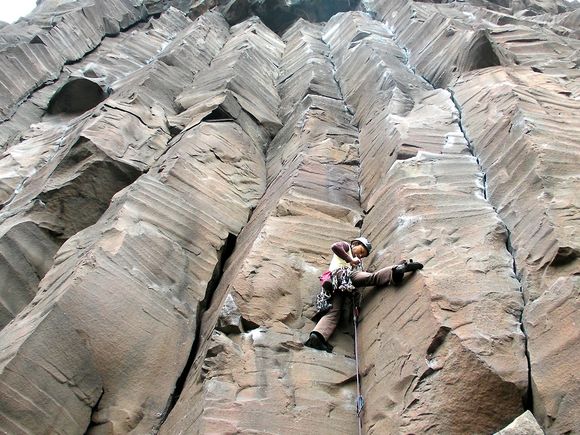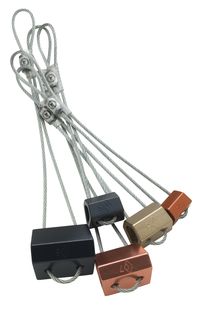╠ř 
Traditional climbing, where climbers place their own removable protection, is best learned slowly. Which is not at all what I did. My first stab at the sport was a thinly-protected 5.5 route up a tower in Devil's Lake, Wisconsin. Easy, but my partner had never lead-belayed before, and I almost beaned her when I fumbled a set of nuts halfway up the route. On my third lead, a hex walked out of the crack I was climbing, leaving me looking at a ground fall from near the top of the route. As exhilirating as they were, those first few adrenaline-fueled leads were far from enjoyable: trad, done correctly, should be more fun than fear. Here's my advice on how to get started right.
Get Solid
Think of your gear like a seat belt: it can save your life if something goes wrong, but there's no sense in putting that to the test. Before you think about getting on the sharp end, you should feel solid and comfortable on the rock. Invest some time in learning to climb cracks of different sizesÔÇöthese are typical terrain for trad routes.
For your first few leads, pick dead-simple, low-angled routes that offer plenty of opportunities to place protection. With leads as easy as 5.1, Joshua Tree National Park in Southern California is a good place to start. Don't hog the lead, either: you can learn a lot by following more experienced climbers and watching how and where they place gear.
Learn to Build Anchors
The best way to learn to place gear is by building anchors. Besides being a useful skill, building toprope anchors lets you figure out what works and what doesn't without the stress of having to do it 70 feet up a rock face. Get an experienced friend to teach you or seek out professional instruction. The gives lessons on anchor-building right in the heart of Yosemite Valley ($154 per person for the group class).

Go Passive
There are two basic categories of trad gear: active protection, which consists of spring-loaded devices like cams, and passive protection, which includes nuts, hexes, and other metal chocks that you use by wedging them into constrictions in cracks. You're better off starting on passive gear. Because passive pro is harder to set than active pro, it forces you to be deliberate and careful about your placements. It's also cheaper: you can buy a light passive rack for the price of one or two cams.
Start with a set of nuts. 's Stopper Set Classic ($62.50) will protect seams through finger cracks. For wider stuff, go with BD Hexentrics ($9.95-15.95), which have remained almost unchanged since Yvon Chouinard invented them in the 1970s. While they don't cover as wide of a range as more modern curved hexes, Hexentrics' straight sides and clean corners make it easy to tell if a placement will hold or not.
One word of warning: while passive gear works fine in most places, it won't hold in perfectly parallel-sided splitter cracks. If you plan on spending a lot of time climbing somewhere where those are the norm, like southern Utah, you'll have to get cams.
Get the Right Shoes
Thin-soled, downturned shoes may be great on steep sport routes and bouldering problems, but they won't cut it on long trad lines. Look for a comfy, flat-lasted shoe that's burly enough to take being stuffed in a crack over and over again. Out of all the crack climbing shoes I've tried, my favorites by far are La Sportiva's . Designed with input from master El Cap climber Tommy Caldwell, the high-top Pros have stiff soles and enough padding in the ankles to all but eliminate the pain of repeated, aggressive jamming. On the flipside, they perform clumsily on face climbs, and their $170 price tag is the highest of any shoe on the market.
If you'll be on trad routes that involve a good deal of face climbing, you'll want a shoe that edges and smears as well as it jams. “For all-around traditional climbing, you will usually be on granite or basalt,” says pro climber Steph Davis, who in 2005 became the first woman to free climb the Salath├ę Wall on El Capitan. “Look for about mid-range stiffness.╠ř I like velcro closures rather than lace-ups so you can pop them off easily at ledges.”
Photo: Courtesy of Black Diamond.